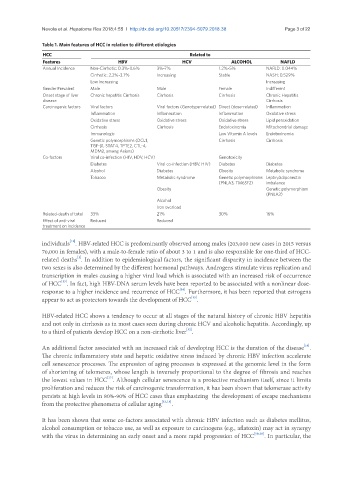Page 576 - Read Online
P. 576
Nevola et al. Hepatoma Res 2018;4:55 I http://dx.doi.org/10.20517/2394-5079.2018.38 Page 3 of 22
Table 1. Main features of HCC in relation to different etiologies
HCC Related to
Features HBV HCV ALCOHOL NAFLD
Annual Incidence Non-Cirrhotic: 0.3%-0.6% 3%-7% 1.2%-5% NAFLD: 0.044%
Cirrhotic: 2.2%-3.7% Increasing Stable NASH: 0.529%
Low Increasing Increasing
Gender Prevalent Male Male Female Indifferent
Onset stage of liver Chronic hepatitis Cirrhosis Cirrhosis Cirrhosis Chronic Hepatitis
disease Cirrhosis
Carcinogenic factors Viral factors Viral factors (Genotype-related) Direct (dose-related) Inflammation
Inflammation Inflammation Inflammation Oxidative stress
Oxidative stress Oxidative stress Oxidative stress Lipid peroxidation
Cirrhosis Cirrhosis Endotoxinemia Mitochondrial damage
Immunologic Low Vitamin A levels Endotoxinemia
Genetic polymorphisms (DCL1, Cirrhosis Cirrhosis
TGF-β1, STAT4, TPTE2, CTL-4,
MDM2, among Asians)
Co-factors Viral co-infection (HIV, HDV, HCV) Genotoxicity
Diabetes Viral co-infection (HBV, HIV) Diabetes Diabetes
Alcohol Diabetes Obesity Metabolic syndrome
Tobacco Metabolic syndrome Genetic polymorphisms Leptin/adiponectin
(PNLA3, TM6SF2) imbalance
Obesity Genetic polymorphism
(PNLA3)
Alcohol
Iron overload
Related-death of total 33% 21% 30% 16%
Effect of anti-viral Reduced Reduced
treatment on incidence
[12]
individuals . HBV-related HCC is predominantly observed among males (203,000 new cases in 2015 versus
70,000 in females), with a male-to-female ratio of about 3 to 1 and is also responsible for one-third of HCC-
[1]
related deaths . In addition to epidemiological factors, the significant disparity in incidence between the
two sexes is also determined by the different hormonal pathways. Androgens stimulate virus replication and
transcription in males causing a higher viral load which is associated with an increased risk of occurrence
[13]
of HCC . In fact, high HBV-DNA serum levels have been reported to be associated with a nonlinear dose-
[14]
response to a higher incidence and recurrence of HCC . Furthermore, it has been reported that estrogens
[15]
appear to act as protectors towards the development of HCC .
HBV-related HCC shows a tendency to occur at all stages of the natural history of chronic HBV hepatitis
and not only in cirrhosis as in most cases seen during chronic HCV and alcoholic hepatitis. Accordingly, up
[12]
to a third of patients develop HCC on a non-cirrhotic liver .
[16]
An additional factor associated with an increased risk of developing HCC is the duration of the disease .
The chronic inflammatory state and hepatic oxidative stress induced by chronic HBV infection accelerate
cell senescence processes. The expression of aging processes is expressed at the genomic level in the form
of shortening of telomeres, whose length is inversely proportional to the degree of fibrosis and reaches
[17]
the lowest values in HCC . Although cellular senescence is a protective mechanism itself, since it limits
proliferation and reduces the risk of carcinogenic transformation, it has been shown that telomerase activity
persists at high levels in 80%-90% of HCC cases thus emphasizing the development of escape mechanisms
from the protective phenomena of cellular aging [12,18] .
It has been shown that some co-factors associated with chronic HBV infection such as diabetes mellitus,
alcohol consumption or tobacco use, as well as exposure to carcinogens (e.g., aflatoxin) may act in synergy
with the virus in determining an early onset and a more rapid progression of HCC [19,20] . In particular, the

